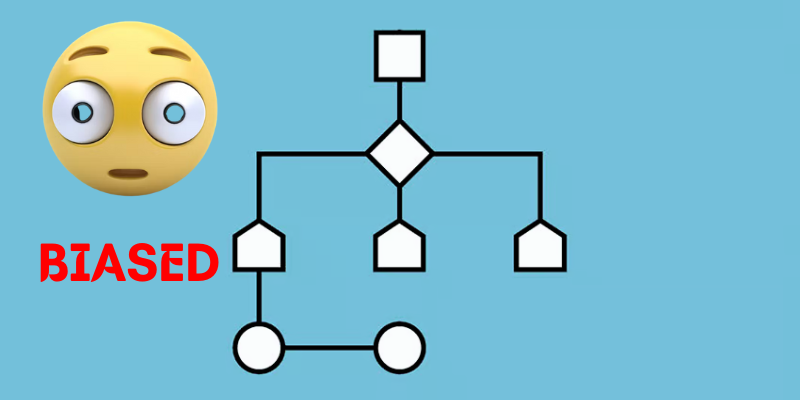AI content writing is a powerful tool that can help businesses create engaging and relevant content for their audiences.

What is AI Content Writing?
Using artificial intelligence (AI) to create text for different goals, such as marketing, blogging, fiction, etc. is called AI content writing. AI content writing tools rely on large language models (LLMs) like GPT-3 and GPT-4 to process input data and generate relevant and coherent text. Some of the advantages of AI content writing are that it can help you write more quickly, effectively, and creatively.
However, it also comes with some risks that need to be considered and avoided. In this blog post, we will discuss some of the most common risks of AI content writing and how to prevent them.
1. Biased Algorithm
Bias is a major problem with AI. It depends on the information you give it to guide it. But the information you give may not reflect the diversity and complexity of the real world. For instance, if your AI learns from data that favour a certain gender, race, or ideology, it may create content that shows and strengthens those biases. This can harm your reputation, lose your customers, and even cause legal problems.
Create Amazing Websites
With the best free page builder Elementor
Start Now
To prevent biased algorithms, you need to make sure that your data is diverse, balanced, and unbiased. You also need to check and test your AI often for any biases and fix them as soon as possible. Moreover, you need to be clear about how your AI works and what data it uses, and provide ways for human feedback and intervention.
2. Factual Inconsistencies
Fact-checking is a key skill for keeping credibility, which is a vital part of writing. However, AI may not be able to confirm the truth and reliability of the information it creates or uses. For example, if you ask your AI to write a news article based on a tweet or a headline, it may not be able to check the source or the context of the information. It may also confuse facts from different sources or makeup details that are not true.
To prevent factual errors, you need to give your AI high-quality and trustworthy data sources. You also need to check and edit the content created by your AI before publishing it. Furthermore, you need to mention your sources and provide references for your readers to check the information.
3. Risk of Search Engine Penalties
There are many search engines today such as Bing, Google and Yahoo, among which the most widely used is still Google.
Google spokesperson John Mueller didn’t clarify how well Google can detect AI-generated content, but he explicitly stated that the webspam team could act against automated content if it is found. It is clear that using AI to create SEO content will be a risky game. Especially with Google’s helpful content updates.
4. Bot Voice
Voice is the distinctive tone and style of your content that reflects your brand personality and values. However, AI may not be able to capture or replicate your voice effectively. For example, it may sound too generic, robotic, or unnatural. It may also lack emotion, humor, or creativity.
To avoid bot voice, you need to provide your AI with clear guidelines and examples of your voice and tone. You also need to customize and personalize your AI-generated content according to your audience's preferences and needs. Furthermore, you need to inject some human elements into your content, such as stories, anecdotes, or opinions.
5. Unintentional Plagiarism
Unintentional plagiarism is a risk of AI content writing that happens when AI-created content has sections that are very close to existing work, without proper attribution. This can happen because AI content writing algorithms take information from different sources to make content, which may lead to copying or paraphrasing without recognition.
Unintentional plagiarism can harm the trustworthiness and reputation of the writer, as well as expose them to legal risks. To prevent unintentional plagiarism, writers need to review their AI-created content for any signs of copying or paraphrasing and mention their sources. They also need to use high-quality and trustworthy data sources for their AI content writing tools.
6. Malicious Content
Malicious content is any content that is meant to harm or trick others. However, AI may not be able to tell between good and bad intentions or ethical and unethical behavior. For example, it may create content that is rude, hateful, or discriminatory. It may also create content that is false, misleading, or fraudulent.
To prevent malicious content, you need to set clear limits and rules for your AI and watch its output carefully. You also need to secure your AI from external interference or hacking by using strong security measures. Moreover, you need to follow the laws and regulations of your industry and country regarding content creation and distribution.
7. Lack of Ideas
Lack of ideas is a risk that AI writing presents because AI cannot create new ideas or concepts by itself. It only copies the patterns it learns from the data it is trained on, so there is a risk of making unoriginal or repetitive content if you rely entirely on AI for writing. Strong ideas and thought leadership content need human creativity, critical thinking, and domain expertise, which AI cannot offer.
Final Thoughts
AI content writing is a powerful and innovative technology that can help writers produce high-quality content faster and easier. However, it also has several risks that writers need to know and avoid. These risks include plagiarism, bias, factual errors, bot voice, malicious content, and lack of ideas. To avoid these risks, writers need to use AI content writing tools ethically and responsibly, and always review and edit their AI-created content before publishing it.
They also need to use high-quality and trustworthy data sources for their AI content writing tools and give clear guidelines and examples of their voice and tone. Furthermore, they need to adhere to the laws and regulations of their industry and country regarding content creation and distribution. By doing so, writers can enjoy the benefits of AI content writing without harming their credibility and reputation.




